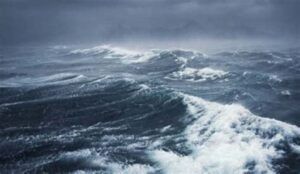
The Cape of Storms has always been notorious for wrecking ships. Records began when the first Europeans started to explore the world. There have been hundreds of wrecks around the South African coast. Some of them have become very famous such as the Arniston and The Birkenhead, and others have just sunk into the crowded ship’s graveyard within the South African waters.
Records of shipwrecks around the Western Cape coast go back 500 years. Portuguese navigator Bartolomeo Diaz first rounded the Cape in 1488. However, only very few of these could be said to be true “treasure ships” that carried large amounts of gold and silver coins or other treasures.
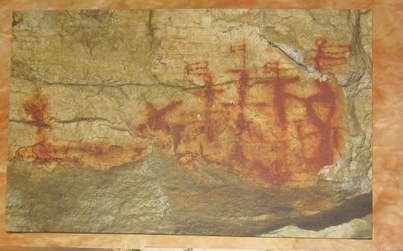
Rock art found near Porterville
Coins or jewellery recovered from shipwrecks were mostly personal possessions carried by wealthy passengers and officers. However, the Birkenhead was said to have been carrying a military payroll of £240,000 in gold coins. The gold coins are thought to have been intended as payment for soldiers fighting in the Eastern Cape border wars.
One of the best-known shipwrecks that yielded a lot of gold coins was the Merenstein. It hit the reefs on 3 April 1702 near Saldanha. Only 99 of the 200 people aboard the Merenstein survived. There were several chests of silver coins intended for trade in the East Indies. Salvage plans were immediately undertaken but the area was difficult to dive and all attempts were abandoned. However, the wreck was discovered in the early 1970s and around 15000 Dutch silver Ducatoons from the 1600s were found. It is believed that this was only part of the treasure that was aboard the ship
The weather patterns that give rise to storms around the Cape originate at the latitude of 40 degrees South (known as the roaring 40s) where the winds circle the earth in a westerly direction. The reason these winds become so strong is that there is not much land to slow them down. From time to time a low-pressure system circulates and breaks off the 40s and heads towards the western coast of South Africa causing huge waves and thick fog. The storms lash at the coast causing the seas to become treacherous. This was the reason that the Dutch East India Company developed a safe harbour in Simon’s Town where ships would overwinter.
Ships had to make a choice whether to “hug” the coastline risking being smashed on submerged rocks, or head further out to sea and extend the journey by many days.
The number of wrecks along the Western Cape coastline attest to some unfortunate choices, and often just some sheer bad luck.
Some people have made an interesting hobby of diving shipwrecks, some even make a living from these unfortunate stories. There are even enterprises that do guided dives. Where a ship has wrecked more than 60 years ago, the artefacts are off limits as the vessel and anything connected with it become the property of the state. No salvage or commercial exploitation is allowed at the historical wreck sites within 24 nautical miles of the coast. There have however been interesting artefacts that have washed up onto the beaches which hint at the treasures that lie on the sea bed. the Shipwreck Museum in Bredasdorp has collections on display of some of these treasures.
In times gone by when ships wrecked close to the shore, the salvaged goods were often auctioned on the closest beach. There is a beach named Smits Winkel (Smits’shop) possibly from this time. Many early houses along the coast were furnished with salvaged goods such as sailcloth and ship’s furniture, sometimes roof trusses were made from packing crates and parts of the ship hull. See Arniston ( Kassiesbaai “crates bay”) Sometimes surviving sailors made their homes with the indigenous people and often married into the district, their knowledge and heritage is reflected in building styles adopted by the locals such as the whitewashed and thatched fisherman’s houses that can be seen in various villages along the coastline.
The sea route around the Cape is still the main route for the transportation of oil from the Middle East to Europe and North America. About 12,000 ships round the Cape every year. It is estimated they carry over 30 million tons of crude oil. Wreckages of these ships can cause environmental havoc and SANCCOB is an NPO that has been set up to rescue sea birds impacted by oil spillage.
Below is a list of shipwrecks most of them (but not all) are recorded by the South African Heritage Resources Agency. The list is long but by no means complete, many more ships have been lost off the Southern Cape coast. Some of the wrecks listed do not have exact dates recorded but notable however are some significant dates. There were a disproportionate number of wreckages listed that happened on New Year’s Day, (I counted 14) whether this is due to bad luck or sailors’ hangover, there is no record. Some years seem to have been unluckier than others 1879 was a bad year with 7 wrecks recorded. 1861, 1871, 1874 and 1877 saw 5 wrecks each, four in 1965, three the year the Birkenhead sank and there were 6 in 1996. October seems to be the safest month in which to travel by ship around our coastline, May and June being more risky of course there is January! There were 32 wrecks in January from the records I found.
1673 The De Grundel was a Dutch wooden sailing vessel/Hooker that sank near Betty’s Bay on the 20th of February and on the 23 August of the same year The Zoetendal a Dutch wooden sailing vessel (Flute) wrecked off Struis Bay.
1680 The Ternate a Dutch wooden sailing vessel wrecked at Hangklip on the 1st of July 1680
**1682 The Joanna a wooden sailing vessel (East Indiaman) wrecked 19km west of Cape Agulhas (Near Asfontein) on the 8th of June. It was the first East Indiaman to be wrecked off the South African coast. A considerable amount of gold was on the ship.
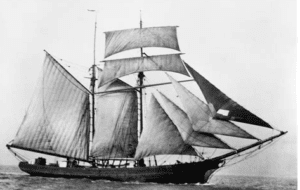
Schooner
1686 The Jupiter 1 was a Dutch wooden sailing vessel (Yacht) that wrecked at Struis Bay Cape Agulhas on the 1st of January 1686. The Nossa Senhora dos Milagros was a Portuguese wooden sailing vessel (East Indiaman) that wrecked at Struis Bay on the 16th of April
1702 The Merenstein A Dutch East India built in 1693 was a Dutch pinnace of some 826 tons under the command of Captain Jan Subbing,
1722 The Schoonberg was a Dutch wooden sailing vessel (East Indiaman) that sank at Northumberland Point on the 20th of December
1729 The Saxenburg a Dutch wooden sailing vessel (Provisions Ship) wrecked at Cape Agulhas on the 9th of January
1733 Die Jonge Thomas at Paarden Island. This was where Wolraad Woltemade drowned attempting torescue the passengers and crew
1734 Huijs Te Marquette was an East Indiaman that was damaged in a storm during June. Extensive repairs were carried out and she returned to Holland.
**1750 The Le Centaur a French wooden sailing vessel (East Indiaman) sank at the Ratel River mouth on the 19th of January
1750 The Elephant was a Danish ship that ran ashore close to Gourits River while on a homeward-bound voyage from Tranquebar, India on 8 August. She was trying to reach Mossel Bay but was wrecked deliberately to save the lives of the desperately illcrew. No lives however were lost; the crew of 65 managed to walk to Cape Town.
1752 Kron Princess van Denmark was a Danish East-Indiaman that was damaged in a storm. It put into Mossel Bay on 9 June 1752 but was abandoned after her cargo had been saved
1763 La Fortune was a French man-o’-war that wrecked opposite the freshwater spring near Kanonpunt in Vleesbaai in the Gourits area on 11 September. It was on a voyage from Reunion. None of the crew of 441 soldiers and sailors were lost. They travelled overland to Cape Town. A cannon from the ship is wedged in the rocks and can be seen at very low tide. All valuables were removed from the wreck at the time. The area name ‘Fransmanshoek’ honours the Frenchmen who survived the wreck.
1766 The Meermin a Dutch Wooden Sailing Vessel (Hooker – Cape Packet) wrecked at Cape Agulhas on the 22nd of February
1780 The Mentor was a Dutch wooden sailing vessel (East Indiaman) that wrecked at Cape Agulhas on the 5th of January
**1783 The Nicobar a Danish wooden sailing vessel (East Indiaman) wrecked at Ratel River Mouth on the 11th of July 1783
**1785 The Brederode a Dutch wooden sailing vessel (East Indiaman) struck a reef off Cape Agulhas on the 3rd May
1789 The HMS Guardian was a 44-gun Royal Navy Roebuck class ship that was badly damaged by an iceberg. It sailed 1900 km to the Cape where it was deliberately scuttled on the24 December 1789
1794 La Jardiniere was a French wooden sailing vessel that sank at Zoetendalsvlei Struis Bay on the 1st of January and The São José Paquete Africa was a Portuguese slave ship that was wrecked on the rocks off Cape Town on 27 December. Over 200 slaves drowned. The wreck was rediscovered in the 1980s but was only positively identified in 2015.
1796 The Lord Hawkesbury was a British wooden sailing vessel (Whaler) that wrecked at Zoetendalsvlei (Struis Baai)on the 26th of May
1799 The HMS Sceptre was a 64-gun third-rate ship from the Royal Navy line that was blown ashore in Table Bay on the 5th of November. There were heavy losses.
1803 The John a British wooden sailing vessel (Brig) that wrecked at De Kelders on the 16th of September
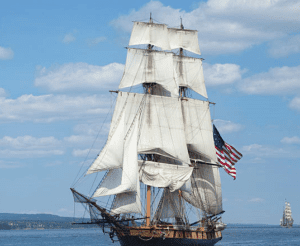
Brigantine
1806 The Staaten Generaal a Batavian republic,renamed Bato. On returning to the Cape she was found to be in a bad condition and turned into a gun platform and anchored in Simon’s Town to guard the approach. After the battle of Blaauwberg, she was scuttled to prevent her from falling into enemy hands in January 1806.
1809 The Edward a British wooden sailing vessel sank at Zoetendalsvlei & Schoonberg Bay (Agulhas )
**1815 Arniston was a British wooden sailing vessel (Barque) that wrecked North of the village of Anniston (Named after the ship that wrecked.) on 30 May
1822 The Grace a British wooden sailing vessel that wrecked Near Ratel River Mouth on the 1st of January 1822
1824 The Mary was a British ship of 547 tons, built of teak in 1813, that wrecked in Mossel Bay on 9 July after putting in for water en route from Calcutta and Madras to London. The cargo included indigo dye.
1826 The Martha was a British wooden sailing vessel (Brig) that wrecked at Martha Point Arniston on the 24th of September
1828 The Meridian was a British wooden sailing vessel (Brig) that wrecked East of Silverstrans Bay on the 19th of May.
1829 The Phoenix was a Dutch East India merchant vessel that was wrecked near Simon’s Town on 19 July. The Jessie a British wooden sailing vessel sank near Ratel River on the 7th of October the same year.
1831 The George was a wooden sailing vessel (Cutter) that wrecked at Dyer Island on the 13th of May
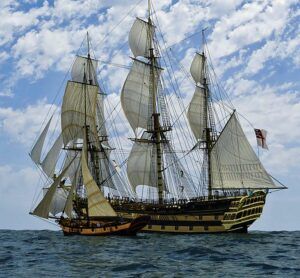
Cutter
1834 The Linnaeus was a British wooden sailing vessel (Barque) that hit a Reef off Dyer Island on the 16th of January. The Locust was a South African wooden sailing vessel (Brig) that sank at Breede River Mouth on the 2nd of September in 1834
1836 The Skerne a wooden sailing vessel (Brig) ran aground on an inside bar on the Breede River on the 14th of June. The Doncaster a British Barque sank at the Ratel River mouth on the 17th of July 1836
1838 The Duke of Northumberland a British wooden sailing vessel (East Indiaman) wrecked at what is now named Northumberland Point (Struis Bay) on the 25th of August 1838
1840 The Venerable was a British wooden sailing vessel (Brig) that wrecked off Struis Bay on the 22nd of February. The La Lise was a French wooden sailing vessel (Cargo Ship) that sank near St Mungo Point, Struis Bay on the 9th of March. The Malton was a British wooden sailing vessel that sank at Walker Bay near Hermanus on the 18th of October
1841 The Sir William Heathcote was a British wooden sailing vessel (Brig) that hit a sandbank (opposite Mrs Dunn’s House) on the 15th of April 1841. No information on where Mrs Dunn’s house was.
1842 The Waterloo was a British convict ship that was driven ashore in Table Bay on the 28th of August along with the troop transport ship, The Abercrombie Robinson.
1843 The Don-La-Toinla was a wooden sailing vessel that sank at Taljaners Bay Arniston on the 1st of January
1844 The Flamingo a wooden sailing vessel sank at Schoonberg Bay (Struis Bay ) on the 3rd of September. The John and James a British wooden sailing vessel (Barque) wrecked at Danger Point on the 1st of September 1844 The St Mungo a British wooden sailing vessel sank at St Mungo Point Cape Agulhas on the 20th of September.
1845 The Port Fleetwood a British wooden sailing vessel (schooner) wrecked at Struis Bay on the 5th of January. The Princeport Reef was a British sailing ship that wrecked off Dyer Island on the 19th of March in 1885
1845 The Martha was a Brig that wrecked 3 km from Mossel Bay in the evening of 30 She was en route from Sydney to Table Bay with 20 immigrants and a large cargo of mail. No lives were lost, and the mail was saved.
1846 The Gentoo was an American wooden sailing vessel that sank at Northumberland Point Struis Bay on the 29th of April. The Fleetwood a British sailing vessel sank at Struis Bay on the 15th of September 1846.
1846 Galatea was a British wooden brig of 223 tons built in 1829 at Chepstow. It wrecked on the rocks of Mossel Bay early on 10 October. Four people were drowned.
1847 The Geortryder wrecked at Cape Agulhas on the 15th of March. The Isaac was a sloop that sank off Struis Bay on the 6th of March 1847
1848 The Harriet Lee a British Schooner hit a sandbank on the bank of Breede River on the 8th of March. The Nancy was a schooner that was wrecked in Mossel Bay on 5 April. One seaman drowned and The Maid of the Thames was a wooden sailing vessel that sank at Skipskop on the 1st of January that year.
1849 The Claudine a British barque sank at Martha Strand near Ryspunt Arniston on the 21st of February.
1849 The Kate was a schooner that recked in Mossel Bay on the night of 16 July. No lives were lost. She lies in the same spot as The Mary (1853).
1850 The Duchess of Buccleugh a British barque sank near the Ratel River Mouth on the 13th of June.
**1852 The Birkenhead was a British rock iron paddle steamship/frigate that wrecked on a submerged rock near Gansbaai on the 26th of February. The Bodiam Castle a British wooden sailing vessel (Schooner) wrecked at Struis Point on the 13th of August. The Juno was a Dutch sailing vessel that wrecked at Cape Agulhas Point directly below the lighthouse on the 2nd of March and The Montgomery was an American vessel that sank at Cape Agulhas on the same day
1853 The Mary was a Schooner of 117 tons that wrecked in Mossel Bay on 16 February. One seaman was drowned. She lies in the same place as Kate
1853 The Barbara Gordona, a British wooden sailing vessel was wrecked at the Ratel River on the 5th of May. The Sophia was a British wooden sailing vessel /Schooner that wrecked at Witsand two days later.
1854 The Arfron, was a German sailing vessel (brig) wrecked at the East bank of Breede River Mouth on the 7th January. The Cancellor a British wooden sailing vessel sank at Martha Strand Arniston on the 12th of September and The Drei Thurne was a German Brig that sank at Struis Point on the 30th of December that year.
1856 The Equator was a British sailing vessel that wrecked at Struis Bay on the 7th of February and The Japarra was a Dutch barque that sank off Quoin Point on the 3rd of October, Two wooden sailing vessels both wrecked on the Southern Cape coast Barrys 1 at Struis Bay on the 4th of April 1848 and Barrys 2 on a Bar of Breede River Mouth on the 5th of July 1857
1857 On the 1st February 1857 the Albert a South African wooden sailing vessel/ Schooner wrecked off Danger Point and The Peacock a sailing vessel/cutter sank at Uilenkraal Riversank on the 8th of May.
1858 The Onward was a sailing vessel/schooner that sank near Zoetfontein Cape Agulhas on the 14th of January 1858
1859 The Atlas was a Dutch wooden sailing vessel/barque) that wrecked at Atlas Reef near Martha Duinen Arniston on the 18 January and The Osmond was a Danish brig that sank at the Breede River on the 1st of June.
1860 The Otto was a Russian sailing vessel that wrecked near Otter Bay Struis Bay on the 20th of January and The Scotland a British ship wrecked at Montgomery Point Cape Agulhas on the 27th of June. and The Underley wrecked Between Agulhas and Quoin Point on the 24th of December.
1860 The Argyle was a Barque carrying bags of linseed and bales of cotton. She ran aground in July
1861 The Port Beaufort hit the bank of the Breede River on the 1st of January and alsoThe Ellen a British wooden sailing vessel/barque wrecked at Struis Point on the same day, The Miles Barton a British wooden sailing vessel wrecked on what is now called Miles Barton Reef near Arniston on the 8th of February and The Star of the East a British wooden sailing vessel wrecked at Ryspunt, Struis Bay on the 10th April, no lives were lost. The Waldensian was a British iron screw steamship/coaster that wrecked at Bulldog Reef, Struis Point on the 13th of October.
1862 The Melbourne was a wooden ship of 1,170 tons; built in 1853. On the way from Shanghai to London she struck rocks near the Gourits River Mouth on 4 November. She carried valuable cargo including silk, wool, copper, tobacco and spices. Three lives were lost.
1863 The Willem de Zwyger, which was a Dutch wooden sailing vessel/barque was wrecked off Martha Point near Arniston on the 30th of March and The Evelyn a South African Wooden Sailing Vessel/Schooner hit Sunbeam Rock on the 18th of December.
1864 The Lucy a South African rock sailing vessel/brig wrecked at Birkenhead on the 16th of February
1864 Dennia was an English brig of 180 tons that was wrecked at Mossel Bay on a journey from London with general cargo.
1865 The Eastern Province a British iron screw steamship sank near Ratel River Mouth on the 26th of June, The Kadie a South African iron screw steamship ran aground on the West bank of the Breede River on the 17th of November and The Ethelrida a British sailing vessel/Barque sank at Skipskop on the 30th of November.
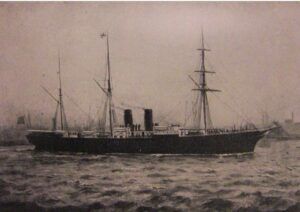
Iron screw vessel
1866 Ruby previously called Figilante was a British schooner of 75 tons that was wrecked at Mossel Bay on 13 January during a strong gale. She was sailing from Algoa Bay to Cape Town with a cargo of rice. No lives were lost
1868 The Borderer a British Iron vessel struck the Middle Blinder of a Reef off Struis Point on the 27th of October.
1869 The Eastern Empire wrecked at Struis Point on the 26th of June 1869, The Sparfel was a French schooner that wrecked off Struis Point on the 4th of September and The Amersham a British sailing vessel/barque wrecked West of Struis Point on the 19th of September
1870 The Hemba was an iron vessel that wrecked off Struis Bay on the 14th of September.
1871 The Queen of the Thames was an Australian iron screw vessel/sailship wrecked at Ryspunt/Skipskop Arniston on the 18th of March, La Souvenance a French wooden sailing vessel sank off Quoin Point on the 19th of May, The Convenance wrecked at Struis Bay on the 22nd of May 1871, The Hecuba wrecked off Northumberland Point Struis Bay on the 17th of July and The Mackay De Mond a British barque sank 1.5km from Heuningnes River on the 12th of September.
1872 The Maggie wrecked West of De Mond, Struis Bay on the 1st of January and the Stella a sailing vessel/schooner wrecked near Port Beaufort on the 30th May 1872
1872 Annie Benn was a schooner of 50 tons. It was built in Knysna in 1867 and wrecked in Mossel Bay on 27 November 1872. She had been carrying a full cargo bound for Cape Town.
1872 Susan Pardew was a wooden barque of 378 tons, built in 1863 by Hardie, of Sunderland wrecked at Mossel Bay on 28 April. No lives were lost.
1872 Erin was a barque wrecked at Mossel Bay on 27 November. She had just loaded part of her cargo destined for London
1873 Elizabeth A Oliver an iron-framed wooden sailing vessel (barque) wrecked at Struis Bay on the 14th of January.
1874 On 24 March 1874 the Albatross a Norwegian sailing vessel/schooner wrecked off Danger Point, The Minnie was a South African sailing vessel that wrecked at the Breede River on the 8th June, C P was a French barque that wrecked at Struis Bay on the 5th of October, The Cospatrick was a British wooden 3-masted full-rigged sailing ship that caught fire and sank on the 17 November 1874 just South of the Cape 369 lives were lost, The Momina Zino was an Italian sailing vessel/barque that wrecked at Klippestrand, Arniston on the 25th of November 1874.
1874 Santos was a German schooner of 163 tons bound for Cape Town with a full cargo of skins, dried fruit and wool. It wrecked on Santos Beach after her cables parted during a heavy swell on 18 July. No lives were lost.
1876 The Edie Waters was an American sailing vessel/schooner that wrecked off Celt Bay on the 10th of January. The iron steam troopship SS Saint Lawrence was wrecked on Great Paternoster Point. Bound for Cape Town. She was carrying the 2nd Battalion of the 3rd Buffs. Fortunately, no lives were lost
1877 The Emelia was a British schooner that sank North-east of Dyer Island on the 3rd of February, The R P Buck was an American barque that sank West of Agulhas on the 4th of April 1877, The Charmer a British wooden sailing vessel/full-rigged ship) wrecked at the North West Point of Dyer Island on the 24th of August, The Piccadilly was a British wooden sailing vessel that wrecked at Celt Bay (near the cave) on the 5th of November 1877 and The Marie Elise was a French sailing vessel that sank 3 days later on the 8th of November at Ryspunt.
1878 The River Plate was a schooner that sank at Buffeljags River Mouth on the 13th of May
1879 The Mathilda was a schooner that ran aground at Port Beaufort on the 1st of January, The Racer was a British Brigantine that sank 9 miles off Quoin Point on the 27th of January. The Eagle Wing was a British schooner that sank off Quoin Point on the 22nd of February and The Clyde was a British iron screw steamship that hit a reef 1km north of Dyer Island on the 3rd of April The Elise was a German schooner that sank at Struis Bay on the 12th of June 1879 The Contest sank at Cape Agulhas on the 1st of July and The Pisa was an Italian Barque that wrecked at the Bot River Mouth on the 18th of August that year
1880 The Bates Family was a steamship that wrecked southwest of Agulhas on the 2nd of September and The Lady Pryse was a British wooden brigantine of 286 tons, built in 1875 by Evans of Aberystwyth. It wrecked in Mossel Bay during a gale on 6 November. No lives were lost.
1880 Wilhelmine was a German schooner that was wrecked at Mossel Bay on 17 March. She had been sailing from Rio de Janeiro with a cargo of coffee. The vessel and her cargo were sold for £75,000.
1880 Philia was a 236-ton British wooden snow type of brig with square sails on both masts. She was built in 1862 by Mills, of Sunderland and was wrecked at Mossel Bay on 11 January no lives were lost.
1881 The Zara was a British yacht of 152 tons. She sprung a leak near Agulhas, but managed to reach Mossel Bay. She was wrecked in Munro’s Bay in July and declared a total loss.
*** 1881 The Eliza & Ann sank at Struis Bay on the 21st of September 1. The Cape of Good Hope was a South African sailing vessel that sank at Port Beaufort on the 24th of November 1881
1881 The Phoenix was found stuck on the rocks at Noetzie Beach. The ship was deserted and the last entry in the logbook had been written five years previously. It had been abandoned out at sea and somehow blown or brought in on the tides to the beach. There is no information known about what happened to the crew.
1882 The Louisa Dorothea was a German three-masted schooner of 227 tons. Wrecked in Mossel Bay on 29 May during a gale. It had sailed from Adelaide carrying wheat and flour. Three crew members were drowned, but five were rescued by the Rocket Crew. She lies near the Lady Pryse (1880)
1882 The Louise Scheller a German barque wrecked at Hangklip on the 6th of June The Gloria Deo an Italian barque sank at the Ratel River Mouth on the 29th of June.
1883 The Kolstrop a German schooner sank off Dyer Island on the 11th of May, The Hansa was a German sailing vessel that sank off Granger Bay on the 3rd of June and The Umzimkulu was a British iron screw steamship/coaster wrecked at the Breede River mouth on the 16th of June.
1884 The Asiatic was a steamer with sails. 2,084 tons. She ran aground in dense fog at Fish Bay on 25 April but was later re-floated.
1885 The Wigtonshire, a British iron sailing vessel/barque wrecked off Atlas Reef Klippestrand Arniston on the 7th of January 1885
1886 Seagull was a Norwegian three-masted wooden schooner of 373 tons, built in 1886. It wrecked on the beach below de Bakke on 11 March. after a voyage from Rio de Janeiro via Table Bay with a cargo of coffee. Divers found her in 1983 and timbers, copper nails and iron knees were found.
1888 The Trevelyn was a sailing vessel British emigrant ship that wrecked South-west of Agulhas on the 6 May and The Adele a South African sailing vessel/schooner was wrecked at Dyer Island on the 21st of May.
1888 Rosebud was a British three-masted wooden schooner of 341 tons, built in 1876 by Carnegie, in Peterhead, in Aberdeenshire, Scotland, She was wrecked on Diaz Beach on 30 August during a storm. No lives were lost.
1889 The Mary was a British cutter that wrecked at Storms River Mouth on the 8th of July and The South American, a wooden sailing vessel sank at Struis Bay on the 17th of September 1889
1892 The Galinaa sailing vessel sank at Danger Point on the 1st of January. On the 28th of February in 1892 The Alcestis, a British steel screw steamship wrecked at Agulhas.
1892 The Galera was a Norwegian wooden barque of 446 tons that was built in 1873. It wrecked during a gale in the big gully on the west side of Mossel Bay, on 25 August. No lives were lost.
1895 The Dundrennan a British iron vessel sank at Struis Point on the 6th of April 1895
1895 The Greystoke Castle a British iron vessel sank at Martha Point on the 6th of June 1896
**1900 The Kakapo was a British 665-ton schooner-rigged steamship built in 1898 by the Grangemouth Dockyard Company and wrecked at Noordhoek on the 25th of May The Cumeria was a British steel steamship that wrecked off Quoin Point on the 2nd of July 1900.
1902 The Clan MacGregor a British iron screw vessel sank off Martha Point near Ryspunt on the 30th May 1902, The Gustav Adolph was a Norwegian wooden sailing vessel/barque that sank off Kleinmond on the 28th of June The Poseidon another Norwegian wooden barque of 606 tons, built in 1890 in Arendal, county of Aust-Agder, wrecked in Mossel Bay during a south-east gale on the night of 2 September and The Verona was also a Norwegian sailing vessel that wrecked off Danger Point on the 11 August.
1903 King Cenric was a Norwegian wooden sailing ship of 1s 519 tons, built in 1874 by JK Dunlop & Co, St John’s. It wrecked near Dias Beach on 14 November with a cargo of Baltic timber. No lives were lost.
1904 The Lawhill was a South African sailing vessel/4-masted barque that sank near Cape Agulhas on the 1st of July 1904
1905 The Boela was a fishing vessel that sank off Danger Point on the 15th of June
1906 The George T. Hay sank south of Cape St Blaize on 29 March.
1906 The John Patterson was a British wooden paddle steamship/tug that wrecked off Kogel Bay on the 1st of June, Star of the Peace a British steel steamship/trawler wrecked at Quoin Point on the 16th of November.
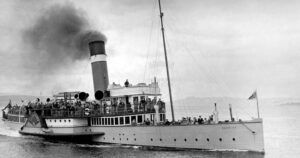
Paddle steamer
1908 The Star of the Isles a British steamship/trawler wrecked off Quoin Point on the 7th of February
1909 The Maori was a Shaw Savill Line steamship that was wrecked near Llandudno on 5 August 1909
1911 The Lusitania a Portuguese 5557-ton twin-screw ocean liner wrecked on Bellows Rock Cape Point. On the 20th of April 1911.
1911 The Lyndhurst was a barque that foundered off Mossel Bay in August.
1912 The Bellona was a British steel screw steamship that wrecked at Stony Bay on the 10th of June The Tasmania was also a British steel steamship (whaler) that wrecked on the 13 of October 1912 near Danger Point
1913 The Hektor was a Norwegian steel steamship that wrecked just South of Dyer Island on the 23rd of March and The Camphill a British steel screw steamship wrecked West of the Cape Agulhas lighthouse on the 27th of March.
1917 The Tyndereus was a British steamship/troopship that wrecked off Danger Point on the 2nd of June 1917.
1919 The Edderside was a Norwegian iron sailing vessel/barque that wrecked at Cape Agulhas on the 5th of July 1919.
1920 The Imp was a South African motor vessel that wrecked at Hangklip on the 4th of June.
1922 The tanker Texanita wrecked 23 miles southeast of Stillbaai on the 7th May 1922
1925 The Sceptre was a British steel steamship/cargo ship that wrecked at Northumberland Point Struis Bay on the 22nd of May 1925
1928 Kingfisher was a fishing trawler that broke her moorings and drifted onto Santos Beach on 14 April. She was declared a total loss.
1929 The Una was a South African wooden fishing vessel/Trawler that was wrecked at Stony Point on the 5th of January 1929.
1932 SS Haliartus previously called ‘Dennistoun’ was a Houston Line steamer of 5294 tons built in 1919 by J Redhead & Sons, of South Shields, on the River Tyne in England. It wrecked in dense fog near Ystervark Point, west of the Gourits River Mouth, on 3 May with a cargo of 1,200 cases of whisky, 40 cars and other goods. Some of the cargo was salvaged.
1935 The Anker, a South African wooden steamship/trawler wrecked at Bulldog Reef on the 11th of February.
1938 The Eclair was a fishing trawler that went aground at Kanon on 12 February. Most of the crew were rescued by the local Rocket Brigade, however, one life was lost.
1941 The Hannington Court was a steel motor vessel (Cargo Ship) that wrecked 10 Miles off Dyer’s Island on the 14th of July.
**1942 The Thomas T Tucker was a Houston-built munitions carrier that ran ashore on Oliphantsbos near Cape Point on the 27th of November.
1943 The Queen Anne wrecked at Cape Agulhas on the 1st of January, The Jimmy Le Roux wrecked at Dyer’s Island on the 28th of April and on the 25 May Agwimonte an American ship wrecked at Cape Agulhas.
1943 The Sabor was a British cargo boat of 52212 tons that was torpedoed by a U Boat on 9 March. Six crewmen were killed, and the survivors were brought to Mossel Bay.
1946 The City of Lincoln a British Steamer was a (Tramp) that wrecked at Quoin Point British on the 9th of November, The Swona a South African salvage motor vessel wrecked Near The city of Lincoln wreck on the 8th of December, The Fynd was another South African motor vessel/salvage vessel that wrecked at Quoin Point on the 18th of December.
1947 The HMS Thames, a former royal navy Mersey class protected cruiser that became famous when it was renamed as SATS General Botha. When it retired as a training ship, it reverted to its original name and was sunk in False Bay near Simon’s Town when it was used as a target on13 May 1947
**1948 The Esso Wheeling was an American motor vessel/oil tanker wrecked at The Point on the 5th of November 1948
1951 Firefly was a 24-ton fishing vessel driven onto Santos Beach in a storm on 30 September. It was a total loss.
1953 On the 10th May The William Hooland which was a South African Motor vessel trawler wrecked West of Quoin Point.
1956 The Adelfotis a Costa Rican steamship wrecked 1km south of Quoin Point.
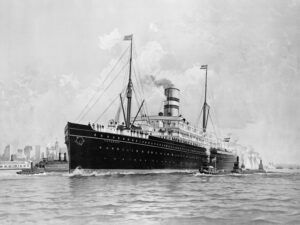
1957 The Steenbok was a motor vessel wrecked at Agulhas on the 24th of June 1957
1959 The Zuiderkruis, a South African motor vessel/fishing vessel wrecked off Walker Bay near Hermanus
1961 The Diana was a motor vessel that wrecked at Quoin Point on the 26th of January 1961
1964 The Debonair was a motor vessel that wrecked at Cape Infanta on the 27th of October and The Alice, a motor vessel wrecked off Arniston on the 22 May 1964
**1965 The Malgas was a motor vessel that wrecked at Struis Bay on the 1st of January The Mary Ann was a motor vessel that wrecked at Cape Infanta on the 27th of February, The Nolloth was a Dutch coaster carrying a cargo of liquor. It struck a submerged rock, most likely Albatross Rock off Olifantsbos in April and the Dolphon was a motor vessel that wrecked 3 miles off Quoin Point on the 23rd of September that year.
1966 The Jeanette was a motor vessel that wrecked at Quoin Point on the 6th of June
1967 The Plato was a motor vessel that wrecked at Cape Agulhas on the 25th of August
1968 The Dirkie Uys a motor vessel wrecked at Cape Infanta on the 11th of March 1968
1971 The Wafra was a Liberian motor vessel/oil tanker wrecked off Cape Agulhas on the 12th of March 1971 it caused a large oil spill. It was later refloated and towed out to sea and re-sunk to prevent further contamination of the coastline.
1973 The Felicia II was a motor vessel that wrecked at Danger Point on the 4th of January 1973
1974 The Dorak was a motor vessel that wrecked on the 1st of January, The Oriental Pioneer was a Chinese motor vessel that wrecked at Northumberland Point (Struis Bay) on the 22nd of July The Bella Gambi a South African motorised ore-oil carrier wrecked at Cape Infanta on the 1st of August.
1974 Cape Hangklip was a trawler belonging to Irvin & Johnson’s. Wrecked near the Gourits River Mouth on 11 September. No lives were lost.
1975 Two ships wrecked on the 1st of January Stromgans a motor vessel wrecked near Danger Point and The Frontalini a motor vessel that wrecked at Danger Point.
1976 The Highly 302, a Taiwanese motor vessel/Trawler wrecked between Randfontein and Walle on the 9th of June 1976
?? 1978 The Pantalis. A. Lemos was a bulk carrier that sank near Saldanha. in 1978
1979 The Shela a motor vessel wrecked at Skuins Bay on the 30th April 1979
1981 Trio–Triomf was a wooden-hulled Irvin & Johnson fishing trawler that ran onto the reef near Kanon in heavy seas on 8 July. The crew was rescued by helicopter.
1982 The Jung Tai was a motor vessel that sank just West of Cape Agulhas on the 1st of January, The Sas President Kruger, a South African navy frigate sank in deep water after a collision with its refuelling ship the SAS Tafelberg on the 18 February and The Meisho Maru 38 a fishing motor vessel/trawler wrecked beyond the Agulhas lighthouse on the 16th November.
1982 Cape Point was a 24-meter Irvin & Johnson trawler. Ran onto rocks near the Gourits River Mouth on 14 March. It was a total loss.
1983 The Seal was a fishing trawler owned by Da Gama Fisheries. Lost her anchor and sank near Danabaai on 5 May 1983, with the loss of one life.
1984 The Otori Maru 8 was a motor vessel that wrecked Near Quoin Point on the 19th of March.
1986 The MFV Harvest Capella was a steel fishing boat that ran aground on the Oudeschip Peninsula
1986 Peter S was a trawler belonging to the Mariette Fishing Company. It sprang a leak and went aground 6 kilometres west of the Gourits River Mouth on 26 August. It was a total loss.
1986 Maranata was a privately owned trawler that got stranded on the rocks near the Gourits River Mouth on 5 September after springing a leak. The crew was rescued by the local N.S.R.I.
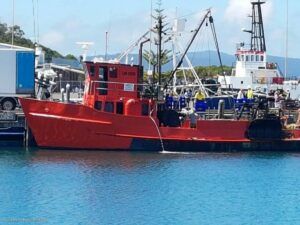
Fishing Trawler
1990 The An-Hung 1 was a Taiwanese motor vessel/trawler wrecked at Holbaai on 22 May and The Perekop was a motorised fishing vessel wrecked at Struis Bay on the 14th of July.
1993 The Augusta a South African motor fishing vessel wrecked East of Cape Agulhas on the 12th of April.**
1994 The British Peer was a three-masted iron sailing ship that ran aground near off the Cape coast.26 June The HMS Pelorus was a British Royal Navy Algerine class minesweeper built in 1943. It was renamed SAS Pietermaritzburg in 1947, and at the end of its career was scuttled to make an artificial reef at Miller’s Point near Simon’s Town on 12 November 1994. The Andre Hugo was a South African fishing vessel that wrecked 11km south of Agulhas on the 16th of October and The BOS 400 was a French derrick bay barge that ran aground on Duiker Point after breaking loose while being towed around the Peninsula by the tug Tigr in a storm. 26 June. In June also The Apollo Sea, a bulk ore carrier, sank near Dassen Island. The resultant oil spill caused environmental damage to the island and threatened its penguin population. 10,000 African penguins of Spheniscus demersus, most of which were collected from Dassen Island 4 076 de-oiled penguins were released with flipper bands.
2000 The Treasure was a Panamanian bulk ore carrier that developed a hole in its hull and sank under tow northwest of Table Bay, causing an oil spill that killed around 2,000 endangered African penguins.
2001 The Ikan Tanda was a cargo ship that ran aground near Cape Town in 2001. It was re-floated and scuttled 320 kilometres from the shore.
2009 On the18 September 2009 A Turkish bulk carrier carrying coal ran aground on Bloubergstrand.
2013 Kiani Satu, travelling from Hong Kong to Ghana with a shipment of rice, ran aground and sank off the coast of Buffels Baai
#Western Cape shipwrecks #Cape Town shipwrecks #Famous shipwrecks Western Cape #Historical shipwrecks Cape coast #Shipwreck diving Western Cape #Shipwreck trail Cape Town #Maritime history Western Cape #Sunken ships Cape Coast #Shipwreck sites Cape Town #Shipwreck museum Western Cape #Shipwreck exploration Western Cape #Cape of Storms shipwrecks #Underwater archaeology Cape Town #Wreck diving sites in Western Cape #Infamous shipwrecks South Africa #Shipwreck stories Cape Town #Lost ships Western Cape coast #Cape Agulhas shipwrecks #Dangerous waters shipwrecks Cape #Gansbaai shipwrecks #Overberg shipwrecks #False Bay shipwrecks #Wrecked ships Cape Peninsula #Maritime disasters Western Cape #Shipwreck heritage Western Cape

